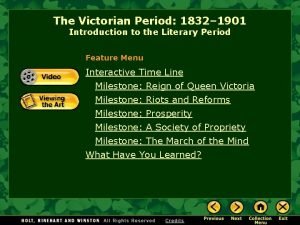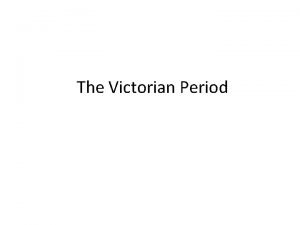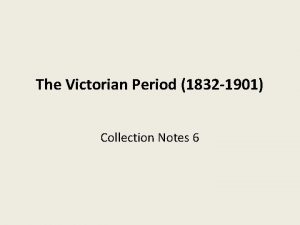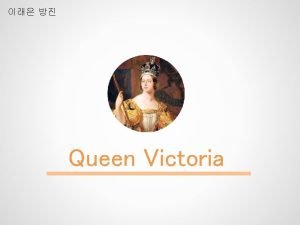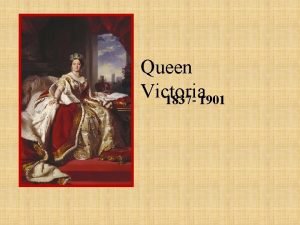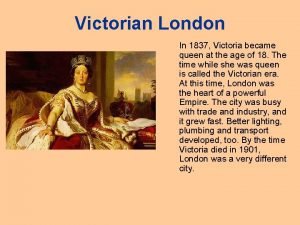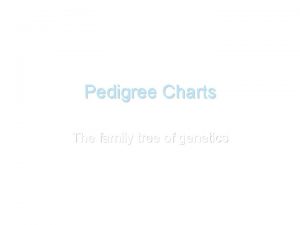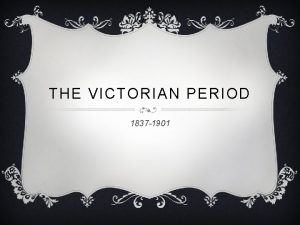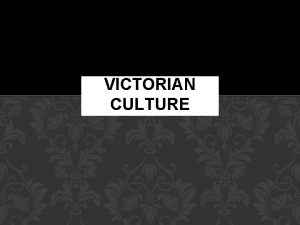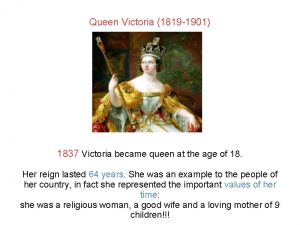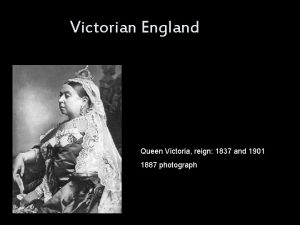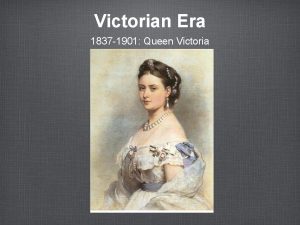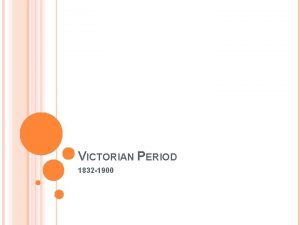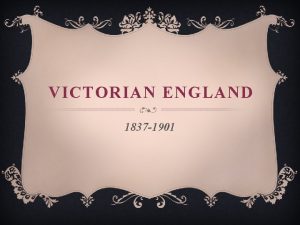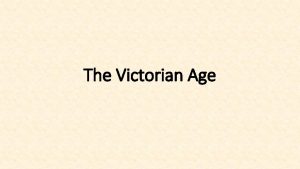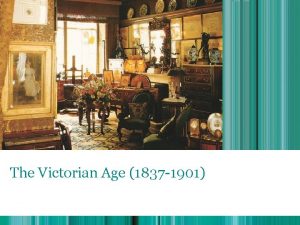The Victorian Period Queen Victoria 1837 1901 Division



















- Slides: 19

The Victorian Period

Queen Victoria (1837 -1901) • Division of the era in time: three periods: • 1830– 1850: period of relative instability, unrest, social protests, Chartist movement in the centre, discontent after the first Reform Bill • 1850– 1870/1884: beginning: Great Exhibition (1851; the Crystal Palace); prosperity, relative stability; • 1870/1884– 1901: sense of loss of power, disillusionment with the prevalent myths of Victorian culture; social protests; Boer war

• Spatial and cultural divisions: – rural–urban; – South–North; – London–other cities; – Periods → a spatial and temporal matrix • Characteristics of the whole period: – middle class values; – masculine and metropolitan; – the steam engine – yet: the idolatry of the feminine and the rural;

The Queen/the Royal family • The cult of the Queen and the Prince Consort (Prince Albert) as the golden model of respectable and happy family life (9 children); • Queen: strong moral ideas • Middle-class values • Elizabethan – Victorian parallels – Englishness, nation – Explorations, colonisation – Modernity, modernisation • 1876: coronation ceremony of Victoria as Empress of India (the Jewel in the Crown)

Legacy of the preceding period 1 • The beginning of the period in terms of culture: a decade of transition, an interregnum • 1810– 1837: Regency period, dandyism – Regency rakes vs the squalor and misery generated by the new industrialism – Nation: split into two: Disraeli’s (later PM) novel (Sybil): the rich and the poor Wordsworth: a classic; Coleridge: lectures on metaphysics; Byron: popularity and disapproval; Shelley: “Yon man Shelley, is just a scoundrel, and ought to have been hanged”; • Shelley’s and Byron’s ideological, political poetry: underground editions, working class readers; • •

Legacy of the preceding period 2 • Keats: – Cambridge undergraduates, the Apostles (Tennyson, Thackeray); – later discovered by the Pre-Raphaelites and by Ruskin; • Walter Scott: appeal: Waverley novels: Victorian idealisation of the age of chivalry (Disraeli) • Victorians with romantic sensibilities and sympathies: – John Henry Newman and John Ruskin (Modern Painters 1843); • Popular literature: emotionalism

The Great Exhibition • 1851: The Great Exhibition of the Works of Industry of all Nations; • “to present a true test and living picture of the point of development at which the whole of mankind has arrived … and a new starting point, from which all nations will be able to direct their further exertions”

• 50 s, 60 s: Progress – Foremost shipper, banker, supplier of manufacured goods – Navy: keeper of peace on mercantile sealines • Statistics: – 1842– 70: market value of British exports quadrupled; – 1851– 1881 gross national income doubled; – 1801– 1901: population quadrupled • Social change: three Reform Bills: 1832, 1867, and 1884 (rotten and pocket boroughs) • Women: excluded; – Women’s suffrage: a central public issue in the second half of the century

Women’s Cause • “The queen is most anxious to enlist everyone who can speak or write to join in checking this mad wicked folly of Women’s Rights, with all its attendant horrors, on which her poor and feeble sex is bent, forgetting every sense of womanly feeling and propriety” • John Stuart Mill: The Subjection of Women; • Middle class women: lives of elaborate idleness; • images: Woman as the vine entwining and relying on the immovable oak (Coventry Patmore: the Angel in the House) • Women’s suffrage: 1918/1928

• • • ”Progress” Sense of constant progress; Cartesian philosophy; Notion of perfectibility; Reshaping the entire legal code Railways: – 1830 and 1848: over 5, 000 mile; – 1889: 15, 000 miles • The underside of Victorianism: – – Urbanisation Poverty Squalor Diseases • Theories and practices of social responsibility: – Utilitarianism/Benthamism (1850 s; Jeremy Bentham) – Evangelicalism (1830 s)

Utilitarianism/Benthamism • Hobbes: the greatest happiness for the greatest number • Self-interest: – Achievement of pleasure and the avoidance of pain; – Without harming others • Thomas Malthus: Essay on the Principle of Population (1798): – – Food increase: arithmetical progression Population increase: geometrical progression Fear: starvation and sickness Poor Laws: workhouses (idea: responsibility) • Adam Smith: The Wealth of Nations (1776): – Natural community of interest – Market: free from intervention – Legislation: to divert egoistic drives into socially beneficial channels • Reforms: universal suffrage

Evangelicalism • Human being: – more than an economic unit and drives – conscience, feelings, senses • Famous representatives: Dickens, Ruskin • A form of Protestant pietism: – Salvation: goal of all earthly actions – Complements utilitarianism by stressing private conscience as opposed to religious dogma • Moral code inherited from the puritans: – – – frugality, self-denial, profitable ethic of work; respectability, opposed to the vanities and frivolities of everyday life; Extreme forms: • • chastity – prudery; diligence–obsession with work; seriousness– bigotry, earnestness–priggishness

Evangelicalism 2 • Contribution to the modernisation and civilisation of Victorian England: – – – abolition of slavery; abolition of flogging; reduction of death penalty from 223 crimes (incl. stealth); amelioration of the worst conditions in prisons; issue of penal philosophy and management in general; philanthropic, missionary and humanitarian organisations • yet: Sabbatarianism; strong pressure group: – conformity; – expurgation of circulating libraries: Bowdlerised versions; – Victorians’ notorious prudery

Other religious movements • Oxford Movement: Catholic-like externalities, ceremoniality and decoration (John Newman); • Low Church: Protestant roots of the Anglican Church • Broad Church (Latitudinarism): a rational church

Secularisation • Secularism and science; • Agnosticism, scepticism • Thomas Arnold: “atmosphere of paradox hanging around many of our ablest young men of the present day”. (1838) • Germany: Higher Criticism: David Friedrich Strauss: Das Leben Jesu (1835—tr. George Eliot 1864)

Sciences • geology: fossils: – the credibility of the Old Testament as cosmic history – versus: the account of geologists – reaction: Philip Gosse: Omphalos: God left the fossils there to seduce disbelievers — The Testimony of the Rock • archaeology: – there were human settlements well before the time that was stated as the beginning of the world – the Creation: 9 a. m. October 23, 4004 BC • palaeontology: – Neanderthaler man: provided a new concept in the 50 s (1856)

• 1859: The Origin of Species • 1871: The Descent of Man • Significance, interpretation: Charles Darwin (18091882) – Human being: not exempt from the perpetual process of change; – Human being: driven by sex and hunger • ideas; became well-known, quite like science in general, created a new culture

Complexity • • • Homogeneity of the period vs subperiods Industrial progress and its undersides Royalty and the middle/working classes Democratisation / women Religion and secularisation/science Free thought, scepticism • In all this: traces of all those contradictory notions that characterise Victorian culture

Thank you for your attention!
 1837 to 1901
1837 to 1901 Victorian period
Victorian period Victorian age 1832 to 1901
Victorian age 1832 to 1901 Is the victorian era named after queen victoria
Is the victorian era named after queen victoria Greek floral arrangements
Greek floral arrangements Byzantine flower arrangements
Byzantine flower arrangements Ceremoniality
Ceremoniality Victorian age 1832 to 1901
Victorian age 1832 to 1901 Portugal e o segredo de colombo
Portugal e o segredo de colombo Florence nightingale 1837
Florence nightingale 1837 Movimento bahiense 1837
Movimento bahiense 1837 During the free banking era between 1837 and 1863
During the free banking era between 1837 and 1863 Movimento bahiense 1837
Movimento bahiense 1837 How did queen elizabeth 1 die
How did queen elizabeth 1 die House of hanover
House of hanover Queen victoria at age 18
Queen victoria at age 18 Queen victoria age 18
Queen victoria age 18 Queen victoria memorial
Queen victoria memorial Queen victoria family tree hemophilia
Queen victoria family tree hemophilia Queen victoria presentation
Queen victoria presentation


